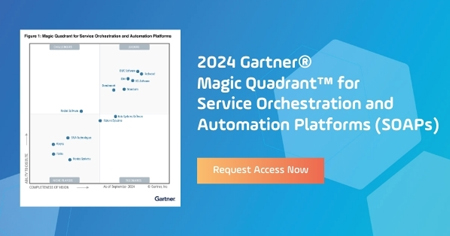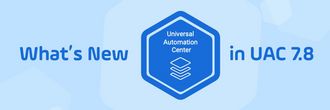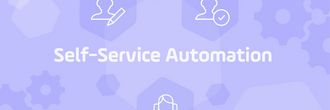Infrastructure Modernization: Automation is the Key
Infrastructure modernization is driven by automation. Explore the benefits of automating your conversion to the cloud and the applications within the cloud.

Infrastructure modernization takes many forms. Some refer to it as digital transformation. Others call it a cloud-first strategy. You may even call it mainframe modernization when moving from the mainframe to the cloud. Cutting through the marketing lingo, all these terms mean essentially the same thing. Companies are moving infrastructure and applications from on-premises data centers to the cloud.
If you're reading this article, you're likely heading down the modernization rabbit hole — which is good. You'll come out the other side with new levels of transparency, self-service, and access for end-users.
IT Automation is a key part of the journey. Unfortunately, many people overlook automation until they're knee-deep in the transition. Conversion teams will quickly learn that the old-school workload automation or job-scheduler tools they used on-premises won't work in the cloud. This article will help you prepare for the conversion and keep everything running when you're done.
What am I Modernizing?
In this case, infrastructure refers to physical hardware and where it resides. Hardware can sit in an on-premises data center, or it can sit in the cloud. Of course, this is a simplified view. Throw in variants like containers, mobile devices, or edge devices, and we need to have a more in-depth discussion. For today, we'll split the world into on-premises and cloud infrastructure.
As mentioned in the opening paragraph, most organizations are trading in legacy infrastructure for cloud infrastructure. However, it's important to note that modernization also includes new hardware within the data center. For example, some companies move from a mainframe to new distributed servers running on-premises. Cost, security, and compliance all majorly affect this decision.
Types of Infrastructure Modernization
When industry analysts talk about infrastructure modernization, they typically talk about infrastructure and applications. Yes, the hardware is being updated. However, hardware and software are tightly linked. In other words, it's generally accepted that organizations are modernizing their entire tech stack when discussing this type of project.
Gartner uses the Five Rs Framework to explain modernizing workloads and legacy applications.
- Replatform
- Refactor
- Rearchitect
- Rebuild
- Replace
Essentially, organizations perform a technology swap. They lift and shift what they already have and move it to the cloud in some way, shape, or form. Or they abandon what they have and move to a cloud-native or SaaS application. If you're unfamiliar with Gartner's 5 Rs framework, check it out here.
The Role of Automation
Automation has been a staple of infrastructure and application management since the beginning. Nothing changes when you move to more modern surroundings. If anything, automating a hybrid environment compounds your complexity.
Infrastructure modernization automation plays three important roles.
- Migration of existing on-premises workload to cloud workloads: If you have Linux and Windows tasks for servers or JCLs (job control language) jobs for your mainframe, they must be re-created to work with your modern servers and applications. Within a large enterprise, there can be tens of thousands, if not hundreds of thousands, of individual jobs to convert. Tools like the Stonebranch Xpress Conversion Tool take the heavy lifting out of the equation.
- Running workload in the cloud: No matter which of Gartner's 5 Rs framework you choose, you still need to automate your modernized applications and workloads in the cloud. This is where legacy workload and job schedulers have trouble keeping up. Look for evolved schedulers with integrations and connections to cloud service providers and SaaS applications.
- Continuing to run workloads in the data center: We've established that most organizations are not simultaneously moving everything into the cloud. Even if your end goal is eliminating your on-premises data center, there will still be a transition period. It's important to find a scheduler capable of automating both on-premises and cloud-based workloads.
Gartner coined a newer category of automation called service orchestration and automation platforms, or SOAPs for short. Capable of managing both on-premises and cloud environments, this class of solutions is where most large enterprise organizations have turned to support infrastructure modernization projects.
Beyond Automation with Orchestration
A big plus for a successful infrastructure modernization project is that your core processes will be automated. Once you have SOAP technology, it's possible to begin orchestration. Orchestration is when you create workflows that connect automated processes between multiple infrastructures and applications. Enterprises often optimize and gain major efficiencies by creating workflows that connect ERP, HRM, CRM, and other business applications.
Orchestration works best when it can run both time-based and event-based triggers. Companies can create real-time processes once they gain event-based triggers via a modern SOAP.
Modernization Use Cases
You don't need to look too far to see infrastructure modernization use cases. A few common ones are:
- ERP tools: Upgrade to new generations of ERP like SAP S/4HANA or RISE with SAP S/4HANA Cloud
- Modernize mainframe applications: Lift and shift applications to cloud environments
- Data storage: Move to cloud storage options like Snowflake
- Cloud infrastructure: Drive the ability to spin up/down infrastructure in both private and public clouds
Summary
Modernizing your legacy infrastructure and applications will profoundly impact your organization. Putting the steps in place to transition from legacy schedulers to modern orchestration platforms is key to your success. You'll gain enhanced security, reliability, and adoption.
Start Your Automation Initiative Now
Schedule a Live Demo with a Stonebranch Solution Expert






